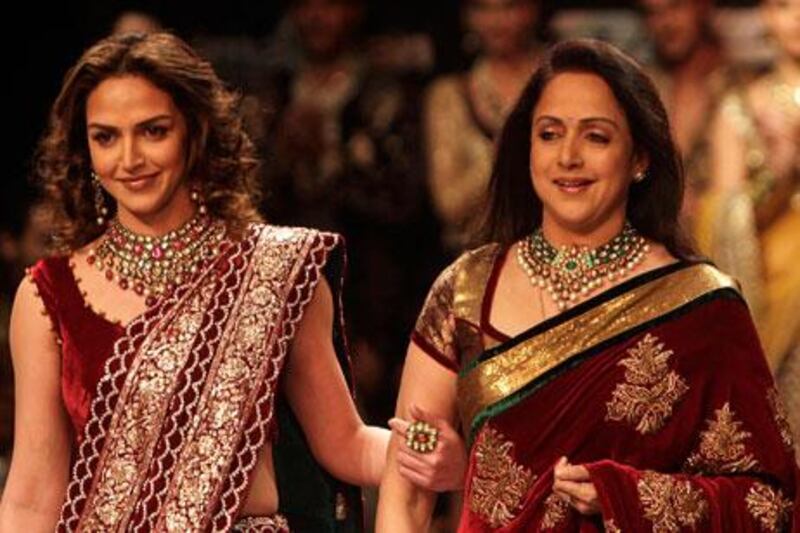Lakme Fashion Week Winter Festive 2011 opened in Mumbai on Tuesday with fanfare one can only expect from the capital of Bollywood. The action took place at the Grand Hyatt Hotel, where India's most prominent designers showcased their latest collections alongside emerging designers hoping to capture the attention of international press and buyers.
"This year we've seen designers becoming more creative, especially the younger ones who are more avant garde," says Vinod Nair, the fashion editor at the Hindustan Times. "Meanwhile, established Indian designers have stayed true to their own style and DNA while showcasing India's heritage and craftsmanship."
Picture gallery: Lakme Fashion Week Winter/Festive 2011
The Lakme Fashion Week Winter/Festive session for 2011 ended on Monday in Mumbai, India, with over 60 designers showcasing their collections.
With wedding season just around the corner, India's renowned couturiers took the opportunity to showcase exquisitely embroidered bridalwear with a modern twist. The Delhi-based designer Rohit Bal kicked off the week with a show that saw the Bollywood actor Arjun Rampal take to the catwalks. The collection, titled Shanti, which means "peace", was serenely beautiful with ivory and gold floor-length ensembles featuring gold corsets and voluminous skirts with appliqué borders. A Spanish influence could be seen in the netted gown decorated with beaded fringing on the shoulders, while colourful floral embroideries appeared on Bal's signature velvet floor-length coats in rich shades of plum and burgundy.
After launching a coffee-table book on photography earlier this year, it came as no surprise that JJ Valaya referenced the subject for his latest collection. Paying homage to the ever-changing colours of the still image, it was all about drama and grandeur as seen in the long gowns with embroidered boleros or bodices and digitally printed saris embellished with crystals. The show closed with a series of colourful lehengas (long skirts) paired with the designer's signature evening jackets in silk, brocade and lamé.
Also creating a regal look was Anita Dongre with a Rajasthan-inspired collection of red, rust and cobalt saris and salwar kameezes featuring handiwork indigenous to the area, including ikat and traditional metallic patterns. Rina Dhaka may have shown traditional tops, skirts and churidars but her interpretation was purely modern, as seen in the off-the-shoulder tops and sari blouses featuring cobweb cutouts. Fabrics such as tulle, lace and Lycra came in a soft palette of ivory, plum, pink and lilac and were embellished with vintage tonal embroideries.
Sabyasachi Mukerjee is probably the most relevant designer working in India today, with a vision that transcends cultures. His show featured ethnic shapes accented with Kashmiri thread work and silver floral embroideries that were stunning in their simplicity. Saris came in a combination of velvet and net and were worn with conservative blouses covered in heavy embroideries resembling jewellery. It was the perfect balance of East and West.
Fusion wear was another popular trend at shows by Vijay Balhara and Archana Kochhar. Balhara referenced European vintage with a breezy collection that included long silhouettes comprising pleated, floor-length dresses, smocks and empire-waist tunics made from natural and fluid fabrics. Kochhar, meanwhile, expertly draped sheer silk and organza into shirt dresses, tunics and jumpsuits, decorated with digital prints featuring Indian calligraphy.
While the old guard proposed traditional clothing, the new generation looked to the West to create modern, contemporary designs. Raman Vij sent out fierce knitwear inspired by Japanese samurai and ninjas. Structured dresses came with layered shoulders and ruffled tiers in muted colours of grey, military green, ivory and brown. Another highlight was the DHL-sponsored Swapnil Shinde's "Speed of Sound" collection, which was sleek and futuristic. He used folds, pleats and rolls made from clear plastic to cover structured body hugging dresses and skirts for a Blade Runner look with a touch of femininity.
Show-stopping red-carpet gowns also got the attention of the social set. High glamour was provided by Jatin Vama in the Paparazzi collection. Sexy and slinky floor-length gowns came with plenty of bling, or in loose flowing shapes with digital animal prints for a contemporary look. Taking a more feminine approach were the Vizyon designers Shraddha Murarka and Nino Palisse, who featured chic, silk cocktail gowns in gold and jewel tones with layers of geometric cut-outs.
Men were not forgotten: several designers featured menswear to accompany their women's looks. Narendra Kumar's Great Gatsby collection referenced classic men's smoking jackets, which were given a modern twist with a leaner shape and in fabrics including textured silk and brocade. Offering something less formal was the New Gen designer Mohammed Javed Khan, with his unconventional layered look for the laid-back urbanite. It was cool, effortless and comfortable.
Lakme Fashion Week closed with a show by Manish Malhotra
For an online gallery of Lakme Fashion Week, visit www.the national.ae/multimedia










